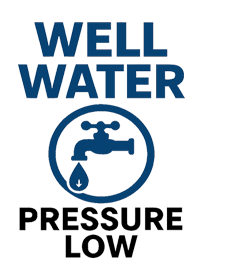An artesian well is a silent marvel of nature—like an ancient library that stores centuries of water in layers beneath the earth, waiting to be tapped. When it flows freely, it’s like an artist’s brushstrokes—a constant, steady stream of water, confident and sure. But what happens when the steady rhythm falters and well water pressure is low? It’s like a song suddenly off-key, a stream struggling against unseen barriers.

While most causes of low pressure are well-known—clogged filters, pump failure, or leaks—there are deeper, less obvious reasons why an artesian well might lose its flow. These rare culprits are harder to spot, but understanding them will help you diagnose and correct the problem, returning the well to its steady, rhythmic pulse.
Uncommon Causes of Low Pressure in Artesian Wells
1. Declining Recharge Rate
An artesian well works on the principle of hydrostatic pressure. It’s like a balloon under constant pressure—ready to release water when tapped. However, if the water table beneath the well begins to fall or the surrounding recharge rate slows, the pressure may not be enough to sustain the flow. It’s as if the well is running dry, even though it’s far from empty. If this happens, you may notice well water pressure low, especially during periods of drought or when there’s excessive pumping in the area.

2. Formation of Mineral Deposits
Over time, minerals in the groundwater—like calcium, magnesium, or iron—can begin to form deposits inside the well casing or on the screen. Think of it as an artist’s paint slowly clogging the bristles of a brush. These deposits can block the flow of water, reducing pressure and restricting the free movement of water through the well. This is a subtle, slow process, often going unnoticed until the well water pressure low becomes noticeable.
3. Fracture Blockage
Artesian wells tap into aquifers formed by fractured rock layers, and over time, those fractures can become blocked with sediment or debris. Imagine a highway that’s been closed off by a landslide—no matter how much you want to drive, the path is blocked. When fractures become blocked, the water can no longer travel freely to the wellhead, causing a decrease in pressure. This is a rare but possible cause of low well water pressure.
4. Contamination of the Aquifer
Though less common, contamination of the aquifer can alter the natural flow of water. If pollutants or foreign materials seep into the groundwater, it can change the chemical composition of the water, making it denser or harder to pump. The system begins to resist, like a clogged artery in the human body, impeding the smooth flow of water and leading to lower pressure.
5. Pumping Too Early or Too Much
If an artesian well is tapped too soon, or if it’s pumped too frequently, the pressure may not have enough time to build up again between cycles. It’s like asking a runner to sprint without time to rest between races. The well system will struggle to maintain consistent pressure, and well water pressure low can result.
Objections & Answers
🛠️ Objection 1: “How could the water table be declining when my artesian well is supposed to be self-sustaining?”
Answer: While artesian wells are naturally pressurized, they still rely on the surrounding aquifer’s water level. If neighboring wells or environmental conditions alter the recharge rate or if the region experiences prolonged dry spells, even an artesian well can suffer from reduced pressure. This is particularly true in areas with significant groundwater extraction.
Objection 2: “Mineral buildup sounds rare. Shouldn’t my well be able to flush itself?”
Answer: Mineral buildup is slow and often subtle. While artesian wells are naturally flushed over time, over many years, mineral deposits can form in places you can’t see, like inside the screen or casing. This can affect flow without immediate symptoms, gradually lowering pressure over time.
Objection 3: “If there’s a fracture blockage, how would I even know?”
Answer: Blockages in fractures aren’t immediately visible, but you may notice sudden drops in pressure that don’t coincide with other common issues like clogged filters. A professional well inspection, using tools like a camera, can help identify the problem beneath the surface.
Objection 4: “Contamination sounds like something I’d notice right away, right?”
Answer: Contamination can indeed be noticeable, but certain chemicals or substances can change the water’s flow properties subtly. If you notice a slight change in water quality—color, taste, or odor—it might be wise to investigate further. A water test can determine if the aquifer has been compromised.
The Rewards of Solving Low Pressure
By diagnosing and correcting these uncommon causes of low pressure, you can restore your artesian well to its full potential:
- Consistent Water Pressure – The well returns to its rhythm, with reliable and constant flow.
- Extended Well Life – Preventing further damage means the artesian well can continue serving your household for years to come.
- Enhanced Water Quality – Clean, fresh water flows uninterrupted through the pipes.
- Peace of Mind – Knowing that your well is healthy and functioning as it should brings comfort and assurance.
The Quiet Power of Artesian Wells
An artesian well, when functioning correctly, is like a poem in motion—quiet, steady, and full of life. But when well water pressure is low, it’s often due to subtle, unseen forces beneath the surface. By understanding and addressing the rare causes of low pressure, you can ensure your well remains a reliable, enduring source of water for years to come.
